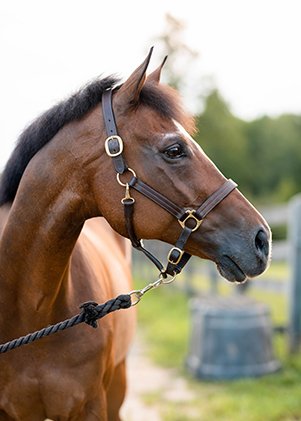Complications after removal of fractured tooth in Texas brings OTTB to the Equine Medical Center for specialized treatment and care
November 3, 2021

Last year, then-17-year-old Valido, an off-the-track thoroughbred gelding, was referred to the Equine Medical Center for computed tomography (CT) of his head.
In February 2020 at an equine hospital in Texas, Valido had a fractured tooth removed via minimally invasive buccotomy. Radiography completed after the extraction revealed a retained root tip, which was reported to have been successfully retrieved a few days after the tooth extraction.
Over the next couple of months, Valido experienced intermittent, malodorous nasal discharge and was treated with needle lavages of his sinuses and oral antibiotics by Steve Trostle of Blue Ridge Equine Hospital, Earlysville, Virginia. Although the gelding’s nasal discharge seemed to resolve, Trostle referred Valido to the Equine Medical Center for further diagnostics and treatment.
An initial oral examination completed by James Brown, clinical associate professor of equine surgery, revealed no foul-smelling odor from the gelding’s right nostril, but partial loss of the clinical crown was evident. Dental endoscopy revealed a partially fractured tooth and additional balance and general tooth maintenance issues, while CT revealed increased soft-tissue density involving the right rostral maxillary sinus, and suspected dental fragments at the caudal buccal root.

Placing Valido under standing sedation, Brown made a skin incision creating access to the rostral maxillary sinus, where granulation tissue and purulent material were encountered. A swab of the purulent material was taken for next-generation DNA sequencing performed by MicrogenDx laboratories in Texas.
Small pieces of dental and bone fragments were removed, and both buccal roots of the offending tooth were removed under endoscopic and radiographic guidance. Drainage access was created between the rostral and caudal maxillary sinus compartments, the sinus was lavaged with antibiotic/dimethyl sulfoxide solution, and a dental plug was placed. The skin flap was closed using non-absorbable suture material, and a head bandage was applied to keep the area clean.
Since Valido’s initial visit to the center, he has returned for suture removal and plug changes.
“I really appreciated the time Dr. Brown took in explaining his findings and options for treatment,” said Valido’s owner Christine French, of Redhouse, Virginia. “Val’s surgeries and recovery involved many procedures over several months. Through it all, Dr. Brown was so good about answering questions, even while on vacation at one point. I was confident that Dr. Brown really cared about Val’s recovery.
“The staff who handled Val whenever I brought him seemed very kind. That helps so much. I travel almost 200 miles to bring Val to the center each time, and it is worth it. Valido is a special horse and deserves good care.”








